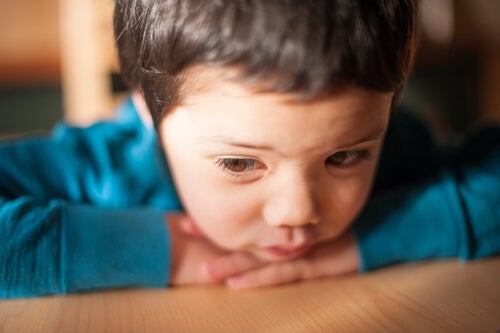Selective Mutism: Symptoms and Treatment

Today, we’re going to talk about selective mutism, a rather complex childhood disorder characterized by a child’s inability to communicate effectively in certain social settings. These children speak in environments where they feel comfortable but have great difficulty communicating in other environments.
This is a childhood anxiety disorder where the social environment plays a modulating role. Relating to others in environments where they don’t feel safe, such as a new school, can be overwhelming. As a result, many end up displaying a total or partial selective mutism in that particular environment, the degree of the mutism depends on the child.
Unlike traumatic mutism, where the child completely loses speech after experiencing a traumatic event, children with selective mutism don’t completely lose their ability to speak. They can speak and socialize in some environments, and with some people. Thus, their mutism is a way of avoiding social anxiety.

How does it develop?
A high percentage of children who suffer from selective mutism have a genetic predisposition to anxiety. They’re children who show signs of severe anxiety and extreme shyness from a very young age.
Statistics also show that many of them have a temperament that favors this often incapacitating condition. Some hypotheses point out that these inhibited children seem to have a low threshold of amygdala excitability. This would make them interpret events or circumstances as signs of potential danger, even when they aren’t.
Only 20-30 percent of them present some subtle speech, language, or learning abnormalities. In these cases, the additional stress makes the child much more anxious in situations where they need to communicate.
A small proportion of these children with inhibited temperament come from bilingual families. Alternatively, they may have spent some time in a foreign country. Therefore, they’ve been exposed to another language during their language development stage (between two and four years of age).
The behavior of a child with selective mutism
It’s important to point out that a child with selective mutism has a normal communicative attitude in environments they feel comfortable in. Parents of these children often comment on how talkative, funny, curious, and even stubborn they are when they’re at home.
The symptoms of selective mutism
Almost all of the symptoms of childhood selective mutism can be attributed to anxiety. Some of them are:
- Temperamental inhibition. Shy and extremely cautious behavior in new or unfamiliar situations. They’re also often inflexible, moody, and domineering at home. These children have a need for control and internal order.
- Social anxiety. More than 90 percent of children with selective mutism exhibit high levels of social anxiety, despite having age-appropriate social skills.
- Various physical symptoms. In addition to mutism, these children often have recurrent stomachaches, nausea, vomiting, headaches, joint pains, shortness of breath, diarrhea, and nervousness.
- It’s quite common for these children to show a neutral facial expression and avoid smiling in social situations that overwhelm them. Even their nonverbal language becomes rigid; they avoid eye contact and seem more interested in playing alone. Some may show these symptoms in the presence of certain groups of children or teachers, but they may interact normally with others.
- They may also experience eating, bowel, and bladder problems. Sensitivity to very bright lights or very loud sounds can also occur.
- They may have difficulty with being touched. This can include sensitivity to clothing labels, as well as being touched by others or having their hair brushed. They’re children with heightened senses, and they’re very perceptive and sensitive.
- Within the classroom, they tend to isolate themselves from others. They have difficulty following instructions and are easily distracted. In spite of this, many children with selective mutism are very intelligent and focus on their studies as a way of avoiding social interaction.
- Comorbid anxiety may appear. This can be in the form of separation anxiety, obsessive-compulsive disorder OCD, trichotillomania (hair-pulling), specific phobias, and panic disorders.

How do therapists treat selective mutism?
Intervention therapies for children suffering from selective mutism are focused on moving from nonverbal to verbal communication. The main goal is to reduce anxiety, boost self-esteem, and develop social and communication skills. There are several approaches in this intervention:
- Behavioral therapy. By using positive reinforcement, the therapist will try to superimpose positive feelings or expectations on their anxiety, thus indirectly blocking the avoidance response (mutism).
- Play therapy. By using psychotherapy and other psychological approaches that help to eliminate the pressure to verbalize and help the child to relax.
- Cognitive-behavioral therapy. In this approach, a therapist will work on the thoughts that produce the anxiety. The understanding here is that, by reducing the child’s anxiety levels, they’ll naturally tend to be more communicative.
Whatever approach is chosen, the solution doesn’t involve forcing the child to talk. Rather, it’s a matter of transferring that sense of security that enables them to talk in certain environments to those in which they don’t have such a high degree of knowledge or control in order to reduce overall anxiety.
Today, we’re going to talk about selective mutism, a rather complex childhood disorder characterized by a child’s inability to communicate effectively in certain social settings. These children speak in environments where they feel comfortable but have great difficulty communicating in other environments.
This is a childhood anxiety disorder where the social environment plays a modulating role. Relating to others in environments where they don’t feel safe, such as a new school, can be overwhelming. As a result, many end up displaying a total or partial selective mutism in that particular environment, the degree of the mutism depends on the child.
Unlike traumatic mutism, where the child completely loses speech after experiencing a traumatic event, children with selective mutism don’t completely lose their ability to speak. They can speak and socialize in some environments, and with some people. Thus, their mutism is a way of avoiding social anxiety.

How does it develop?
A high percentage of children who suffer from selective mutism have a genetic predisposition to anxiety. They’re children who show signs of severe anxiety and extreme shyness from a very young age.
Statistics also show that many of them have a temperament that favors this often incapacitating condition. Some hypotheses point out that these inhibited children seem to have a low threshold of amygdala excitability. This would make them interpret events or circumstances as signs of potential danger, even when they aren’t.
Only 20-30 percent of them present some subtle speech, language, or learning abnormalities. In these cases, the additional stress makes the child much more anxious in situations where they need to communicate.
A small proportion of these children with inhibited temperament come from bilingual families. Alternatively, they may have spent some time in a foreign country. Therefore, they’ve been exposed to another language during their language development stage (between two and four years of age).
The behavior of a child with selective mutism
It’s important to point out that a child with selective mutism has a normal communicative attitude in environments they feel comfortable in. Parents of these children often comment on how talkative, funny, curious, and even stubborn they are when they’re at home.
The symptoms of selective mutism
Almost all of the symptoms of childhood selective mutism can be attributed to anxiety. Some of them are:
- Temperamental inhibition. Shy and extremely cautious behavior in new or unfamiliar situations. They’re also often inflexible, moody, and domineering at home. These children have a need for control and internal order.
- Social anxiety. More than 90 percent of children with selective mutism exhibit high levels of social anxiety, despite having age-appropriate social skills.
- Various physical symptoms. In addition to mutism, these children often have recurrent stomachaches, nausea, vomiting, headaches, joint pains, shortness of breath, diarrhea, and nervousness.
- It’s quite common for these children to show a neutral facial expression and avoid smiling in social situations that overwhelm them. Even their nonverbal language becomes rigid; they avoid eye contact and seem more interested in playing alone. Some may show these symptoms in the presence of certain groups of children or teachers, but they may interact normally with others.
- They may also experience eating, bowel, and bladder problems. Sensitivity to very bright lights or very loud sounds can also occur.
- They may have difficulty with being touched. This can include sensitivity to clothing labels, as well as being touched by others or having their hair brushed. They’re children with heightened senses, and they’re very perceptive and sensitive.
- Within the classroom, they tend to isolate themselves from others. They have difficulty following instructions and are easily distracted. In spite of this, many children with selective mutism are very intelligent and focus on their studies as a way of avoiding social interaction.
- Comorbid anxiety may appear. This can be in the form of separation anxiety, obsessive-compulsive disorder OCD, trichotillomania (hair-pulling), specific phobias, and panic disorders.

How do therapists treat selective mutism?
Intervention therapies for children suffering from selective mutism are focused on moving from nonverbal to verbal communication. The main goal is to reduce anxiety, boost self-esteem, and develop social and communication skills. There are several approaches in this intervention:
- Behavioral therapy. By using positive reinforcement, the therapist will try to superimpose positive feelings or expectations on their anxiety, thus indirectly blocking the avoidance response (mutism).
- Play therapy. By using psychotherapy and other psychological approaches that help to eliminate the pressure to verbalize and help the child to relax.
- Cognitive-behavioral therapy. In this approach, a therapist will work on the thoughts that produce the anxiety. The understanding here is that, by reducing the child’s anxiety levels, they’ll naturally tend to be more communicative.
Whatever approach is chosen, the solution doesn’t involve forcing the child to talk. Rather, it’s a matter of transferring that sense of security that enables them to talk in certain environments to those in which they don’t have such a high degree of knowledge or control in order to reduce overall anxiety.
All cited sources were thoroughly reviewed by our team to ensure their quality, reliability, currency, and validity. The bibliography of this article was considered reliable and of academic or scientific accuracy.
- Muris, P., Hendriks, E., & Bot, S. (2015). Children of Few Words: Relations Among Selective Mutism, Behavioral Inhibition, and (Social) Anxiety Symptoms in 3- to 6-Year-Olds. Child psychiatry and human development, 47(1), 94–101. doi:10.1007/s10578-015-0547-x
- Klein, E. R., Armstrong, S. L., Skira, K., & Gordon, J. (2017). Social Communication Anxiety Treatment (S-CAT) for children and families with selective mutism: A pilot study. Clinical Child Psychology and Psychiatry, 22(1), 90–108. https://doi.org/10.1177/1359104516633497
- Shipon-Blum, Elisa. What is selective mutism? Selective Mutism – A Comprehensive Overview. Selective Mutism, Anxiety & Related Disorders Treatment Center´s blog. Recuperado de https://selectivemutismcenter.org/whatisselectivemutism/
This text is provided for informational purposes only and does not replace consultation with a professional. If in doubt, consult your specialist.







